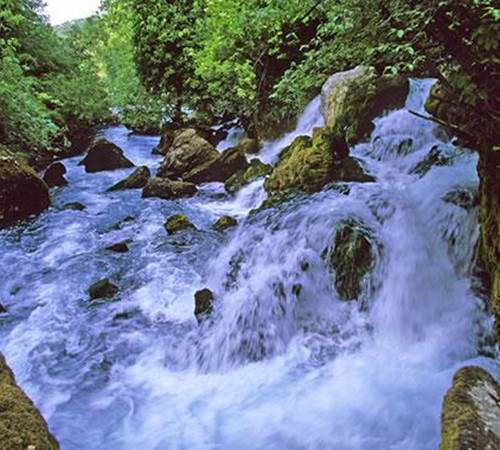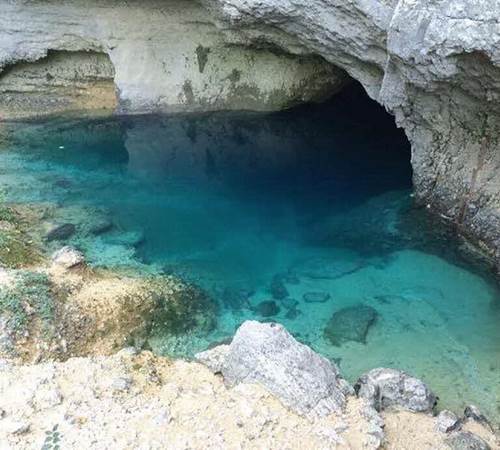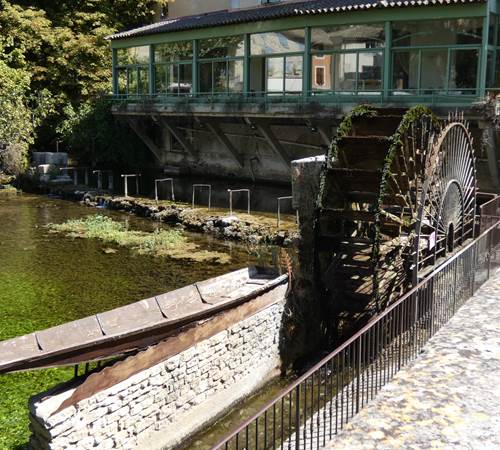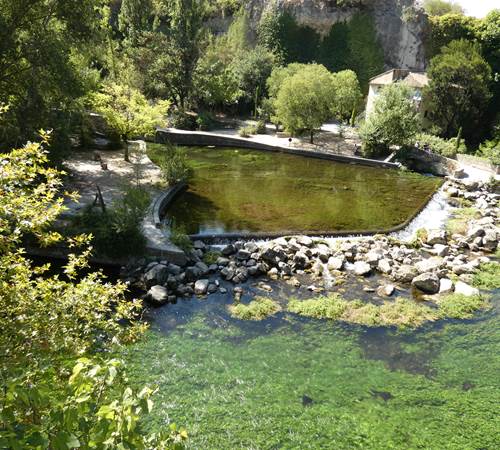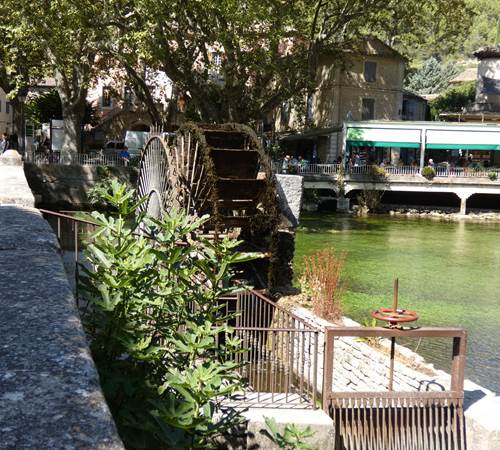Fountain of Vaucluse
Arrival

Departure

Our guide
Virtual walk around the property
a well-being break at Mas Séraphin? and why not a massage?
Products served at the Mas, good, organic and healthy
Ethics, environment and energy charter
Markets and events 2024
By bike in Vaucluse
Walks, hikes and tourist maps
Guides of Provence
The history of the Mas
Fountain of Vaucluse
Pernes les Fontaines
Saumane-de-Vaucluse
Gordes, un village classé parmi les plus beaux de France
Le Vaucluse, c'est ça;))
Les villages du Luberon
Un voyage extraordinaire en Luberon
Located in the heart of the Monts de Vaucluse and the Pays des Sorgues, the most beautiful river in the department, La Sorgue, has its source at Fontaine de Vaucluse. It springs at the foot of a steep 230m cliff, in the hollow of a closed valley, ""Vallis Clausa"" in Latin, which gave its name in 1793 to the Department of Vaucluse.
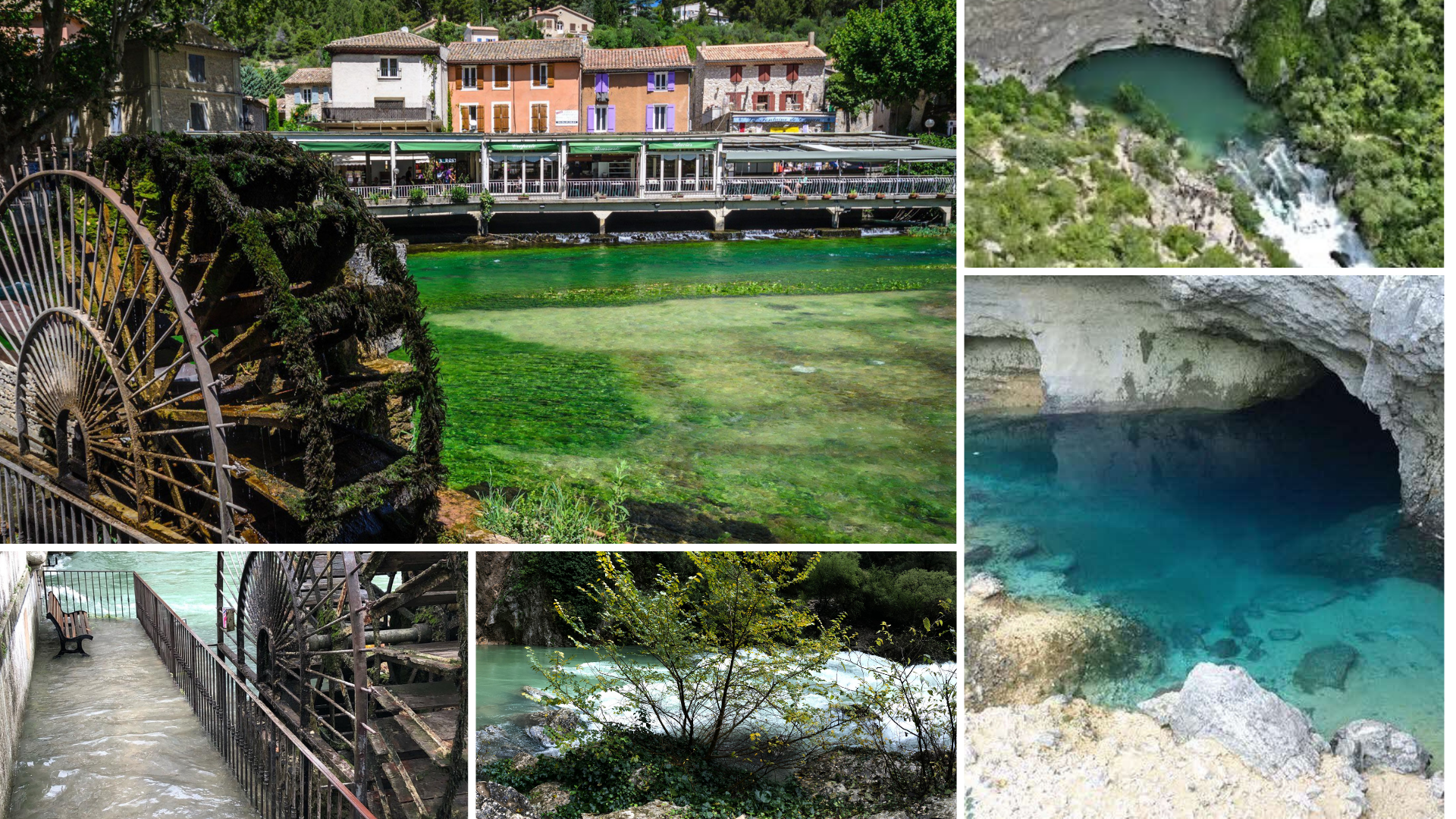
The source of the Sorgue
The spring itself, located 80 meters above sea level, is the largest in France and one of the largest in the world, with a total flow of 630 million m3 per year.
The source of the Sorgue is the emergence of an immense underground network. The waters that spring come from the infiltration of rainwater and melting snow from the south of Mont Ventoux, the Monts de Vaucluse, the Albion plateau and the Montagne de Lure, which represent an "impluvium" of more than 1240 km2 and whose only exit is the Fountain.
A model in the world
Sources around the world operating on the same model as the Fontaine de Vaucluse are called ""Vauclusian sources"". The low and constant temperature of the Sorgue, coupled with an always regular flow, gives this river very good oxygenation. These ideal conditions allow it to accommodate a very diversified ecosystem which has enabled it to obtain classification as a Natura 2000 zone (an approach aimed at preserving biological diversity and enhancing the natural heritage), the Sorgue is also classified as 1st category for the quality and purity of its water, a paradise for fishermen.
endemic species
Among the many species present we can mention the beaver, the nutria, the kingfisher, the mallard, the gray heron, the dipper, the brown trout, the grayling and more surprisingly it is also home to two species of aquatic insects endemic (Rhyacophila vallisclausae and Bythinella sorgica), which only exist here.
Men have always sought to unravel the mysteries of the Fontaine de Vaucluse, many explorations have taken place to better understand its functioning.
The chasm of Fontaine de Vaucluse
Frequented since antiquity by the Romans who worshiped the divinities of the Sources, it was not until 1878 that a Marseilles diver, Mr Ottonelli, explored the abyss and reached a depth of 23 meters equipped with a heavy diving suit. . The boat used during this 1st dive sank and is submerged today.
Descent into the depths
In 1946, it was Commander Cousteau's team that reached - 46 meters, it was the first scuba diving. In 1955, 80 dives with the Ofrs (Cousteau team) made it possible to descend to -76 meters. In 1967, Cousteau sent the Télénaute (robot) which reached – 106 meters.
In 1981 the SSVF (Speleological Society of Fontaine de Vaucluse) resumed research. Touloumdjan, helped by Comex reached -153 meters and Hasenmayer in 1983 reached the exceptional depth of -205 meters, both in scuba gear.The same year, the SSFV immersed the Sorgonaute (wire-guided device) down to – 245 meters. Finally in 1985, the SSFV draws up a new map of the abyss down to -308 meters.
In 2001 the SSFV explored the cavity with the spelenaut from - 40 meters to - 80 meters, these archaeological prospecting dives led to the discovery in 2002 of 400 ancient pieces and in 2003 nearly 1600 pieces were updated, dated for the oldest - 80 years BC and the end of the 5th century for the most recent.
An archaeological treasure
Some of these gold coins dating from the 4th century are of exceptional archaeological value. This is proof that the site was frequented since antiquity and that the Source received offerings during the cult of Water dear to the Romans.
Today, in summer, historical reconstructions with the Roman Imperial Court, in procession to the Source, for an offering ceremony, are offered and meet with great success.
The Fountain of Vaucluse
The Fontaine de Vaucluse presents a very different face according to the seasons, calm and peaceful in summer, as if asleep at the bottom of the abyss, the Source pours in bubbling cascades in spring, with the melting of the snow, and in autumn during heavy rainfall. , the water level gradually rises in the abyss until it overflows in waterfalls on the rocks.
It is an impressive phenomenon of strength and beauty.
The Sorgometer
Since 1869, to measure the height of the water and its flow at the exit of the abyss, we have had the Sorgometer, it is a succession of 25 graduated rulers of 1 m giving the positive levels and 2 additional rulers below zero measuring negative levels. Thanks to the height of the water, we know its flow rate at + or – 200 liters. The "Zero" of the Sorgometer is only reached in the event of severe drought and even in this case, the Source "gives" even more than 4m3 per second...
Before the installation of the Sorgometer, the ancients used the Fig tree to measure the variations of the Fountain, this shrub has no age... it already existed at the time of François Pétrarque (1304-1374) who mentions it in a letter.
In addition to Petrarch who lived for many years in "Vaucluse", other illustrious visitors came to admire the Fountain, we can mention Voltaire, Châteaubriand, Stendhal but also the King of France Louis XVI, the Duchess of Berry or even closer to us. René Char, the child of the Country.
The development of the Sorgues plain
Initially, the plain of Sorgues was a vast swamp, which man drained, cleaned up and developed from the Gallo-Roman era. The result is a vast network of waterways of more than 500 km. Shaped by man, the hydrographic network of the Sorgue works ""in reverse"": it is born from a single arm to then divide into multiple arms spreading out over the plain.
Men have always sought to use the driving force of water, in 1300 a hydraulic sawmill was installed, replaced in 1479 by a hammer intended for the shaping of iron, which in turn was transformed for the copper industry and finally the he whole was sold to papermakers in 1522.
In 1700 it was the golden age! Vaucluse has become the center of the Comtat Venaissin paper industry. In 1869 the paddle wheels were replaced by electric turbines but from 1960, competition became severe and led to the abandonment of this activity, the last factory closing its doors in 1968.
Today, thanks to the "Vallis Clausa" paper mill, we can rediscover this tradition of handmade rag paper as in the 15th century.
The Sorgue in a few figures
Depth of the chasm: 308 m
Average flow: 21 m3/second
Maximum flow: 120 m3/second
Minimum flow: 4 m3/second
Temperature: 11 to 14°
Source: http://www.oti-delasorgue.fr/decouvrir/terre-de-nature/la-source-de-fontaine-de-vaucluse











